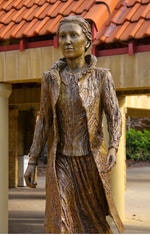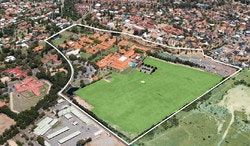Mary Ward Sculpture
On John XXIII Day 2009, a sculpture of Mary Ward was unveiled and blessed by Sr Margie O'Sullivan IBVM. It was indeed appropriate that John XXIII College choose to have this sculpture installed and blessed in 2009 as it is the 400th anniversary of Loreto Education and a year of worldwide celebration. The sculpture is one of eight sculptures made from the same mould by Adelaide artist, Meliesa Judge and her husband Will Kuiper. The other seven sculptures are all installed in the other Loreto schools in Australia ― Ballarat, Mandeville, Coorparoo, Marryatville, Kirribilli, Normanhurst and Nedlands.
The sculpture was commissioned by the Loreto Schools Advisory Committee (LSAC) after the Provincial Assistant for Education, Sr Deirdre Rofe IBVM asked the committee to reflect on the visual environment of Loreto Schools in Australia. She was very keen that students had an accessible and inspirational image of Mary Ward in their school environment. The LSAC members asked several artists to submit possible concept sketches and after a long period of reflection in 2002, Meliesa Judge was chosen as the artist. Her husband, Will Kuiper, has collaborated on the project.
The commissioning of the Mary Ward Sculpture was an attempt to tell the story of Mary Ward in an iconic image that would be a common focus in each of the Loreto Schools. What a challenge! To tell the story to children, adolescents, adults, boys, girls, men and women. Some who would know the story intimately and for others this image would be their first introduction to Mary Ward. It is an incredible story to tell.
Mary Ward was born on 23 January 1585 in the North of England. During the informative years of her childhood and adolescence she was aware of the persecution of the Catholic Community in her homeland. She saw the faith of her family and friends and she decided she wanted to dedicate her entire life to God. Her father wanted her to marry and raise a family but Mary rejected this life in favour of joining a European convent. Despite her commitment to prayer and obedience in the Poor Clare Community, Mary Ward did not believe she was fulfilling God's will. After much anguish she left the Poor Clares to set up her own religious community for women based on the Constitution of the Jesuits. She particularly wanted the apostolic freedom to educate and care for women. Mary encountered many obstacles with the institutional Church, and suffered disappointment, indignity, imprisonment, poverty and sickness as she struggled to win approval for her new community. Eventually her work was suppressed by a Papal Bill and she had to close her convents and schools and return to England. She remained a loyal servant of the Church, despite her unfair treatment, until she died in York, England on 30 January 1645.
To tell such a story in sculpture, Meliesa has used a combination of realism and symbolism. The realism comes from the face which is based on the only known portrait of Mary Ward; her body height and frame size was gauged by her shoe size (one of the artefacts we have of Mary Ward is a pair of walking shoes); her hat, backpack and rosary beads which feature in the sculpture and also housed in a museum in Augsburg.
The symbolism is found in some quirky features ― the lemon representing the secret letters Mary wrote in lemon juice and had smuggled from prison, the paw print representing the perilous nature of her journeys across Europe and, that at least on one occasion, she was lead out of the snow by a dog; and the heel of Mary Ward's foot quashes the Bill of Suppression as she walks confidently forward.
Mary Ward Statue Study Guide

